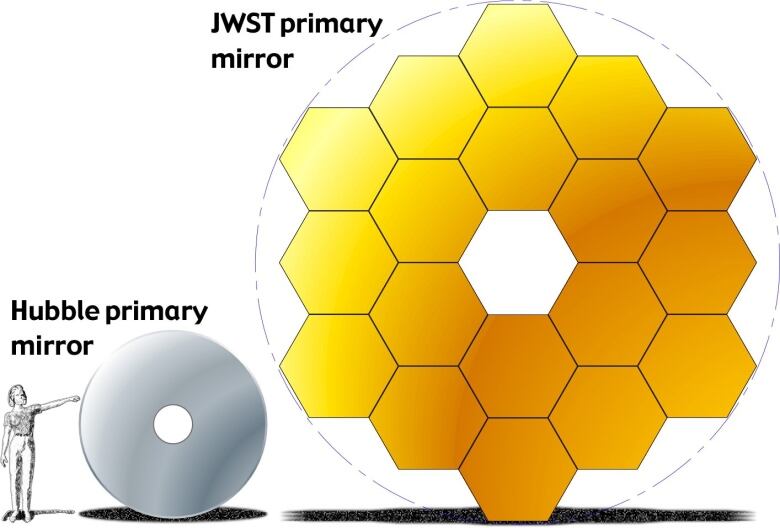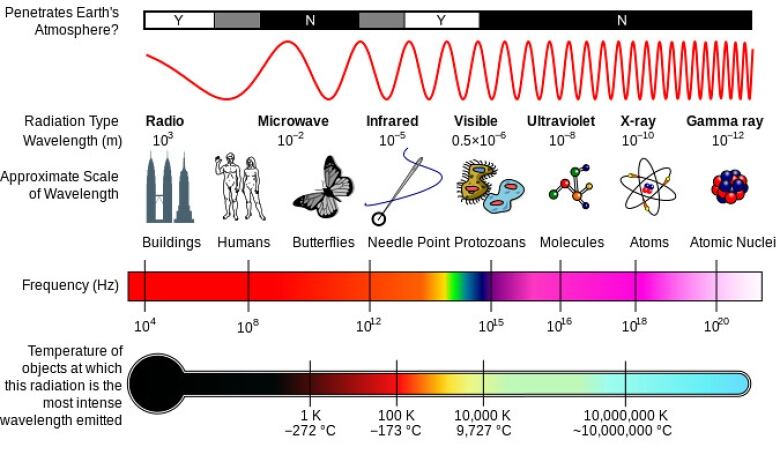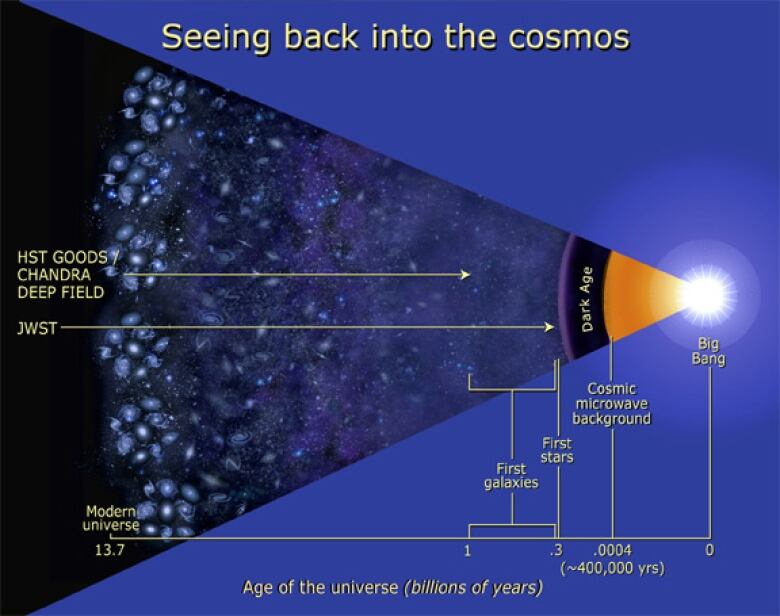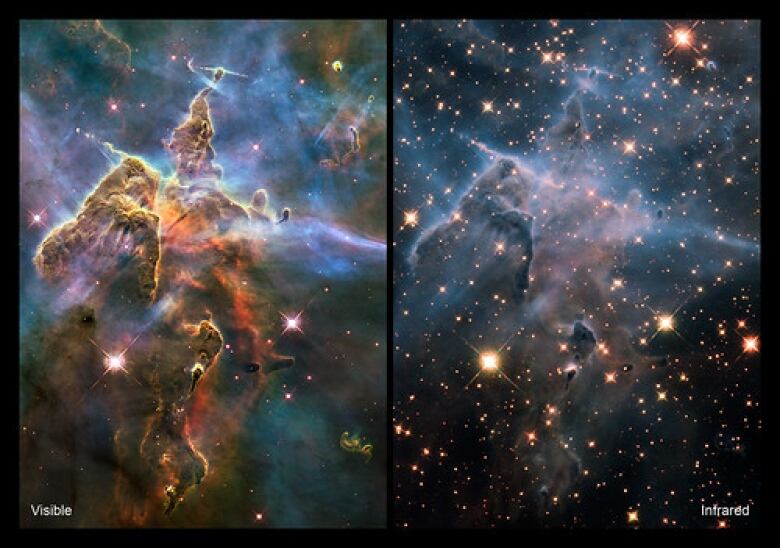Move over Hubble: Why the James Webb Space Telescope is such a big deal
$10B telescope will peer back further in time than any other that has come before it

It's been decades in the making and has faced more than its fair share of delays, but if all goes as planned, the James Webb Space Telescope will launch within the coming days.
Astronomers have been eagerly anticipating the launch of this telescopeand with good reason.
The $10-billion telescopeis the largest and most powerful ever sent into orbit. Building upon the discoveries of the famed Hubble Space Telescope, it will peer back into a time when our universe was in its infancy andwill alsoreveal much more about the atmospheres ofexoplanets.
As of now, the telescopealso known asJWSTor just Webbis expected to launch on Dec. 25 from French Guiana.
'Light buckets'
The light of everything we see in the night sky takes time to travel to Earth. The moon's light takes just over a second to get to us, whilethe sun's light takesroughly eight minutes.
The farther away an object is, the longer it takes for its light to reach us, so everything we see is as it was, not as it is. That means, essentially, when we look at distant stars and galaxies, we're looking back in time.
Telescopes allow us to see further back in time by collecting faint light, which is why they'reoften called "light buckets" by astronomers. The bigger the telescope, the more light it can collect and the further back it can see.
While ground-based telescopes work the same way, they must deal with atmospheric disturbances, which makes them less desirable than space-based telescopes, which are above Earth's atmosphere.
Most people are familiar with the Hubble, launched into orbitin 1990. This workhorse of a telescope has not only provided incredible insight to astronomers about the beginnings of our universe, but has also given us jaw-dropping images of planets, galaxies, nebulas and spectacular clusters of stars.

While people sometimes refer to theJames Webb Telescopeas being a replacement to Hubble, it's more like a younger, stronger brother.
Webb is bigger than Hubble, with new capabilities that will allow us to see the universe from about 100 million to 250 million years after the Big Bang. In essence, we are looking back in time to when the universe was in its infancy.
For comparison, Hubble is big, about the size of a school busbut Webb is about the size of a tennis court. Hubble's mirror, which collects light from distant objects, is 2.4 metres in diameter. But Webb's light-collecting ability is far superior, comprising 18 separate mirrors that will unfold once in orbit, for a total diameter of 6.5 metres.

There's also a difference in the way in which both telescopes look at the universe.
Hubble mainly sees the universe in visible or optical light,detectable by the human eye, though it can also operatein ultraviolet and near-infrared wavelengths.
Webb, though, is optimized to see in the longer wavelengths of infrared, giving it much greater clarity and sensitivity. And this willallowit to peer through dust clouds that might otherwise block the light from distant objects.
What Webb will be able to do
There are two Canadian contributions on Webb:the Fine Guidance Sensor (FGS) and the Near-Infrared Imager and Slitless Spectrograph (NIRISS).
The FGS is critical to the telescope's mission,allowingit to point and focus on particular objects. The NIRISScontains a highly sensitive camera that will gather information to help in the study ofexoplanets.
"Just to give you an idea how accurate this [FGS] camera is, we'll be able to detect an angle of movement of the telescope equivalent to the thickness of a human hair, as seen from one kilometre," said Ren Doyon, principal investigator for the Canadian Webb science team,also withthe Universit de Montral.
"It's just like you being in Toronto, blinking at me, and me, in Montreal, seeing you."

Because Canadahas contributed to Webb, that means Canadian astronomers willhave access to time on the telescope. (Internationally shared telescopes require that astronomers book time to conduct observations.)
Adam Muzzin, an associate professor in the department of physics and astronomy at York University in Toronto, is one of many Canadian astronomers who has already beenallotted timefor his research.
LISTEN | 2James Webb mission scientists talk about the historic telescope:
Muzzin is excited to delve into his specialty:Looking at some of the earliest galaxies to form in our universe, which is exactly what Webb will be able to do.
It's part of a project named CANUCS, or the Canadian NIRISS Unbiased Cluster Survey.
Muzzin and other astronomers have already used ground-based telescopes to look at massive galaxies galaxies that computer models suggest shouldn't exist but have not yet been able to accurately confirm their size or distance.
Muzzin and his team also hope Webb will shed some light,so to speak, on the evolution of galaxies, like our own Milky Way.
"We live in this beautiful Milky Way galaxy.It's gorgeous. You can look up at the night sky, and we know it wasn't always there," he said.
"One of the things we've been really trying to understandfor decades and Webb is going to make a huge leap on this iswhere do galaxies like the Milky Way come from? How do they form? How do they change over time? And why do galaxies like our galaxy look the way they do?"

One of the most anticipated aspectsof Webb is its ability to look at exoplanets. To date, approximately 4,800 exoplanets have been detected around stars, but we still don't know a lot about them.
"Now the big step is to detect the atmospheres [of exoplanets] in order to one day detect life and Webb will do this," Doyon said.
"Hubble started to do it, but it's not big enoughand it doesn't work in the infrared.And to do this work, you need it to work at the infrared wavelength, and so Webb will completely open a new chapter on exoplanet atmospheres."
Ultimately, while Webb has numerous upgrades and new technologies, all of it is geared to the same end: To better understandthe universe and our place in it.
"To me, honestly, it's emotional, man.It really is," Muzzin said. "Itgives me this feeling of warmth, you know, that we're all working together to kind of do something as altruisticas understand our origins;understand where galaxies come from;understand where planets come from. And that's such a beautiful, human thing."













_(720p).jpg)


 OFFICIAL HD MUSIC VIDEO.jpg)
.jpg)



























































































